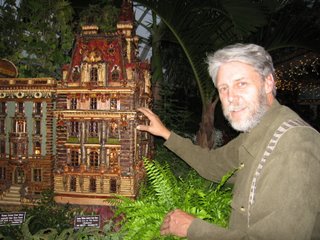All Aboard the Holiday Express

The holiday train show at the New York Botanical Garden isn’t just a miniature extravaganza for railroad enthusiasts – it’s also made for gardeners. It knocks me out that each and every one of the more than 140 replicas of New York City landmarks nestled amid the greenery along the tracks is fashioned from berries and gourds and pine cones and seeds and other plant parts.
It’s amazing but true. I was at the garden the other day reveling in a new exhibit called “Buried Treasures: The Nature and Art of Bulbs” – you can read about it in my Newsday column on Dec. 3 – and I had just enough time to go over to the Enid A. Haupt Conservatory to catch the man who creates the magic.
The trains were chugging, the lights were twinkling and Paul Busse was attending to the finishing touches – making sure all 17 trains were running properly along the 1,300 feet of track that traverses five of the galleries in the Victorian glasshouse.
They were gliding merrily past a Rockefeller Center made of hickory bark and nigella seeds and a Prometheus composed of tree fungus, eucalyptus leaves and acorn caps. Past a Saks Fifth Avenue with balconies of screwbeam mesquite and doors with juniper berry handles, and a Radio City Music Hall with a marquee of tinted radish and catalpa seeds.
 “This is so cool,” Paul said as he showed off the cinnamon-stick scrollwork on the balconies of a 5-foot-tall, 4-foot-wide replica of the mansion that William Andrews Clark – a copper magnate and one-term senator from Montana – put up in the early 1900s. “It was one of the last over-the-top private homes built in the city,” Paul said of the 110-room, six-story residence that required 14 tons of coal a day to heat.
“This is so cool,” Paul said as he showed off the cinnamon-stick scrollwork on the balconies of a 5-foot-tall, 4-foot-wide replica of the mansion that William Andrews Clark – a copper magnate and one-term senator from Montana – put up in the early 1900s. “It was one of the last over-the-top private homes built in the city,” Paul said of the 110-room, six-story residence that required 14 tons of coal a day to heat.Although it took three months to construct, not 12 years like the Beaux-Arts original that once stood at Fifth Avenue and 77th Street, Paul’s miniature version was no small accomplishment. The Clark house, with elm bark corner stones and dentil molding fashioned from long-needled pines, is one of five elaborate homes that Paul created for this year’s show. He calls them “Magical Missing Mansions” because none remained part of the cityscape for more than 60 years.
“I like to have something new every year,” he told me. “And I like to mix things up so if you’ve seen the show before, you’re still surprised and delighted. It’s the season for that.”
With his soft gray hair and beard and his striped suspenders, Paul – a 57-year-old landscape architect with a thing for trains who’s been doing the show for 15 years – looks like someone who could conjure a little holiday magic. He even has elves – a crew of 15 that increases to 25 during the 10 or so days it takes to set up the show. And as you might expect, he has a workshop but it’s on 12 acres in Kentucky – not the North Pole.
Paul works his wonders with sycamore bark and south magnolia leaves and pepper berries and Siberian iris seed pods, with pomegranates and red twig dogwood and grapevine tendrils and walnut shells and honeysuckle stems. “We use a lot of honeysuckle,” he said. “It makes a nice column. It’s very invasive so we pull it out and put it to good use.”
As we walk through the Lilliputian city where the lions in front of the New York public library have manes made of wheat shafts and tails of Harry Lauder’s walking stick, where the fans in the stands of The House that Ruth Built are actually potpourri and the flags on the roof are red oak leaves, Paul talks about how he makes it all happen.
“I study photographs of buildings. I don’t create replicas but everything is in proportion. I capture what I remember, the feeling of the building – the gargoyles, the chimneys, the over-the-top cornices, stuff like that. I’m not necessarily counting windows. I work directly on waterproof signboard. Everything gets hot-glued on it, then soaked in urethane. When I was a kid I would take all the Christmas packages and turn them into houses and create a little village. So I guess all this makes sense.”
It takes a man with Santa in his soul to chose sugar pine cone scales as stand-ins for the Art Deco details on the roof of the Chrysler Building or simulate the sculpture of Mercury, Hercules and Minerva atop Grand Central Terminal with dried strawflowers, arborvitae and yarrow. It takes Paul Busse to make a dried monarch flower and a pomegranate look just like the flaming torch held high by the Statue of Liberty – who is decked out in robes of palm fronds.
Visit the New York Botanical Garden and see for yourself.
